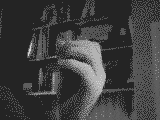Vertical Left Hand Finger Mechanism
© 2001 WPS
The main left hand mechanism used in passage work, trills, scales and
exercises is the vertical action mechanism (or action). This takes place from the knuckles.
Only the fingers themselves should be involved, and force or tension from the forearm
or wrist should be avoided at all costs.
This topic is a large one. At times the vertical span should be greater, and
at times smaller. In fast or rapid passage work, one can only gain the
necessary agility and finger readiness by keeping the distance one lifts the
fingers off the strings fairly small. It is wise to practice fast passages
slowly (in slow motion) , mezzo piano, in order to control and supervise the
softness and coordination of this "miniature" mechanism. Excessive
vertical pressure on the fingerboard can slow down the action considerably. The finger itself, while generally at an advantage when
upright for left hand passage work... can also be used to advantage by not using
the very tip of the finger, but by placing the fleshy rounded, softer part of
the finger in contact with the fingerboard. In general, this is likely to
increase the sensitivity and accuracy of the fingering.
The mechanism should not always be exaggerated, because it largely depends on
lightness, flexibility, agility and evenness. Therefore studying it at a slow
pace, to control the action can lead to a smoother apparatus. Lifting the finger
is more important than dropping or lowering it. Lowering of the finger is
achieved by letting it drop onto the fingerboard aided by gravity. This concept
makes more use of the lifting muscles, which are usually weaker and may need
more attention.
To maximize left hand efficiency, it goes without saying that one must prepare the left
hand in all
passages and string changes mainly by keeping fingers down on the fingerboard ( especially the
first finger ). Economy and good planning help solve difficult passage work.
Below is a rough animation of vertical finger-only action. Don't worry if the
4th finger - or 3rd follows the second in the action... it means you are keeping
them loose and passive, which is the correct concept. Note that the animation
depicts the full path one can take... but in most fast and tricky passages the
finger will not travel nearly as high... in fact it should remain close to the
string in order to economize and be ready and nearby for the next note. The
movement may be studied to a fairly exaggerated degree for beginners who may be
playing at a steady tempo and for
those who need another initial "waking up" of the correct hand
components.
